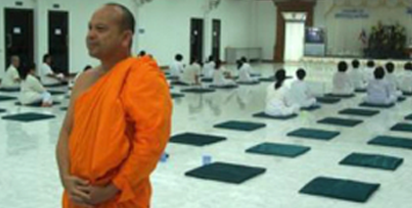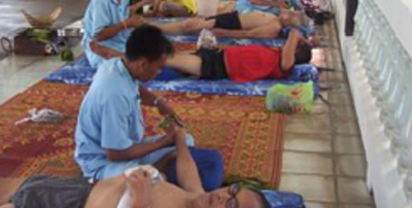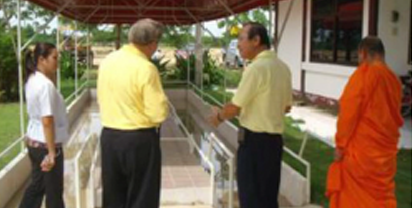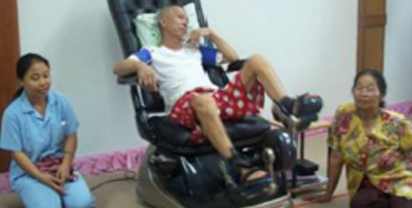Thailand
Our work in Thailand was coordinated as an effort to explore and support a new hospice movement in Thailand. SALC made presentations in numerous university, medical school and community settings.
An Experience of Healing in Thailand
There is a legend about an Indian saint who was abandoned at birth by his mother and was left at the door of an orphanage. Ironically, he became an extraordinarily happy soul who had the capacity to understand the sorrows of others. Rather than allowing the pain of childhood to make him bitter, the experience transformed his soul into a magnet of joyful compassion.
This summer in a mountainous jungle region of northern Thailand, I met another such man. Abbot Phrakru is an unusual Buddhist monk. Father Abbot’s personal story is neither legend nor sentimentality. His mother was a paralytic who gave him up at birth because she was unable to provide a normal life. These unusual circumstances left an indelible impression on the boy. Instead of leaving him scarred with sadness, the orphan developed a strong sense of self-reliance and compassion for others, especially those affected by paralysis.
We spent the morning walking and visiting with this remarkably young spiritual father at his monastery turned-rehabilitation center located in a tropical rainforest. His center is known as the Wat [temple] Tungbopaen located some miles outside of the city of Lampang. His bright saffron robes matched the warmth of a sincere and soulful smile.
Several years ago, Phrakru discovered an abandoned temple near the outskirts of his native town of Lampang. With the help of a small band of fellow monks, he painstakingly began to restore the grounds and buildings, He also attracted local supporters who were interested in the care and rehabilitation of paralytics and quadriplegics. There were no similar services being offered in Southeast Asia.
But Phrakru’s vision was larger than the creation of a traditional medical facility. His foundation now attract international attention for its cutting edge therapies that attracts paralytics from all over the world. Daily physical therapies include herbal baths, body wraps in native leaves known for their healing properties, massage and music therapies. The most extraordinary addition is a walking meditation pond specially constructed for the patients who are unable to walk. In Thai culture, the rice paddy is evocative of connection to nature and the production of the staple food of life. The abbot was inspired to import a significant amount of finely sifted silt from neighboring paddies and added warm, healing waters so that, in spite of their physical limitations, patients can regularly encounter the healing elements of nature.
![Thailand Entrance to Temple [Wat]](https://sacredartofliving.org/wp-content/uploads/2024/07/Thailand-1.png)
Temple [Wat] monastery grounds

Father Abbot Phrakru proposes his center for Sacred Art of Living and Dying Programs

Patients come from all over the world for unique treatment

Rice Paddy Meditation Pond
In addition to its healthcare mission, the temple compound has also been transformed into a retreat center for healthcare workers and the general public. Every month, a new class of spiritual seekers checks in for a week-long program that teaches meditation and holistic health practices for caregivers. The environment of the monastic compound is made available to spiritual seekers from all over the region enriching both visitors and resident monks.
Unlike other facilities that cater to persons who might be able to afford expensive rehabilitation, this monastic facility turns down no own because of financial limitations. With the support of his monastic community, the abbot has also attracted a remarkable team of medical and lay volunteers providing a remarkable ratio of staff to patients. Both professionals and volunteers consistently remarked to us that it was a privilege to work in an environment where the emphasis is on healing-both for caregivers and care receivers. It was as if the abbot’s smile was infectious and visible on the face of every resident and caregiver.
The reputation of this healing sanctuary has now reached the royal family of Thailand who has donated an additional fifty acres to expand the abbot’s programs in coming years. I have rarely experienced such a place of healing and transformation-both of physical and spiritual suffering. Pharukru’s story is a modern reincarnation of the possibility that even life’s tragedies contain the seeds of hope when vision and spirit are put to service. In the end, the abbot extended the use of his remarkable retreat center to host the Sacred Art of Living and Dying series when we return to Thailand in January, 2009. It will be an honor to share the work of Sacred Art of Living Center in such an environment of compassion and spiritual awareness.

Patient with family and volunteer
![Temple [Wat] on monastery grounds Richard and Thai Host, Dr. Nirund with Abbot Phrakru Temple [Wat] on monastery grounds<br />
Richard and Thai Host, Dr. Nirund with Abbot Phrakru](https://sacredartofliving.org/wp-content/uploads/2024/07/Temple-Wat-on-monastery-grounds-Richard-and-Thai-Host-Dr.-Nirund-with-Abbot-Phrakru.png)
Richard and Thai Host, Dr. Nirund with Abbot Phrakru on Temple [Wat] monastery grounds
